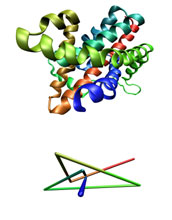Multimedia Gallery
Most Complicated Knot (Image 3)
Most Complicated Knot (Image 3)
The three types of knots found in proteins: from left to right, a knot with three, four and five crossings.
MIT researchers recently found that ubiquitin hydrolase UCH-L3 has the most complicated knot ever observed in a protein. Knots are rare in proteins -- less than 1 percent of all proteins have any knots, and most are fairly simple. The researchers analyzed 32,853 proteins, using a computational technique never before applied to proteins at this scale. Of those that had knots, all were enzymes. Most had a simple three-crossing, or trefoil knot, a few had four crossings, and the most complicated, a five-crossing knot, was initially found in only one protein -- ubiquitin hydrolase. That complex knot may hold some protective value for UCH-L3, whose function is to rescue other proteins from being destroyed -- a dangerous job. To learn more about this research, see the MIT Sept. 20, 2006, News Release, "Knotty Problem Puzzles Protein Researchers."
This research was supported by National Science Foundation grant DMR 04-26677. [From Virnau P. A., Mirny L., Kardar M. (2006) Intricate Knots in Proteins: Function and Evolution. PLoS Comput Biol 2(9): e122.] [One of three related images. See Next Image.] (Date of Image: Sept. 2006)
Credit: Image courtesy Peter Virnau, MIT
Special Restrictions: The terms of the Creative Commons Attribution License apply. Fair use and other rights are not affected. Nonprofit/non-commercial use only.
Images and other media in the National Science Foundation Multimedia Gallery are available for use in print and electronic material by NSF employees, members of the media, university staff, teachers and the general public. All media in the gallery are intended for personal, educational and nonprofit/non-commercial use only.
Images credited to the National Science Foundation, a federal agency, are in the public domain. The images were created by employees of the United States Government as part of their official duties or prepared by contractors as "works for hire" for NSF. You may freely use NSF-credited images and, at your discretion, credit NSF with a "Courtesy: National Science Foundation" notation.
Additional information about general usage can be found in Conditions.
Also Available:
Download the high-resolution JPG version of the image. (1.8 MB)
Use your mouse to right-click (Mac users may need to Ctrl-click) the link above and choose the option that will save the file or target to your computer.

